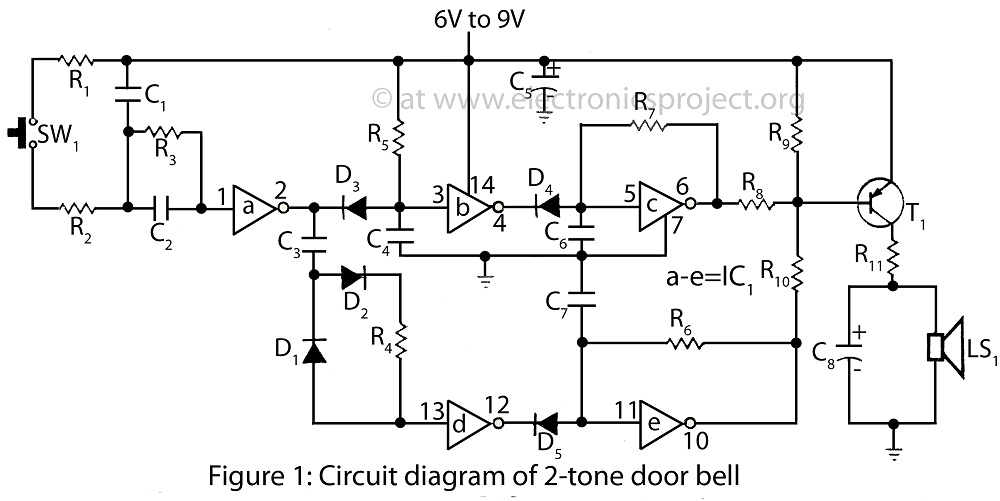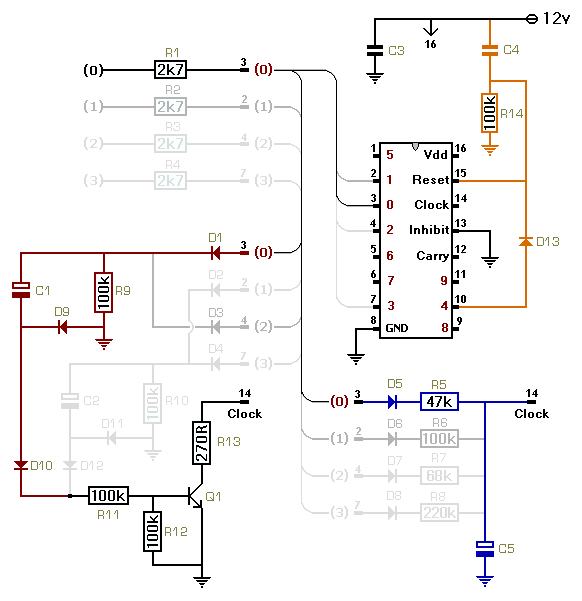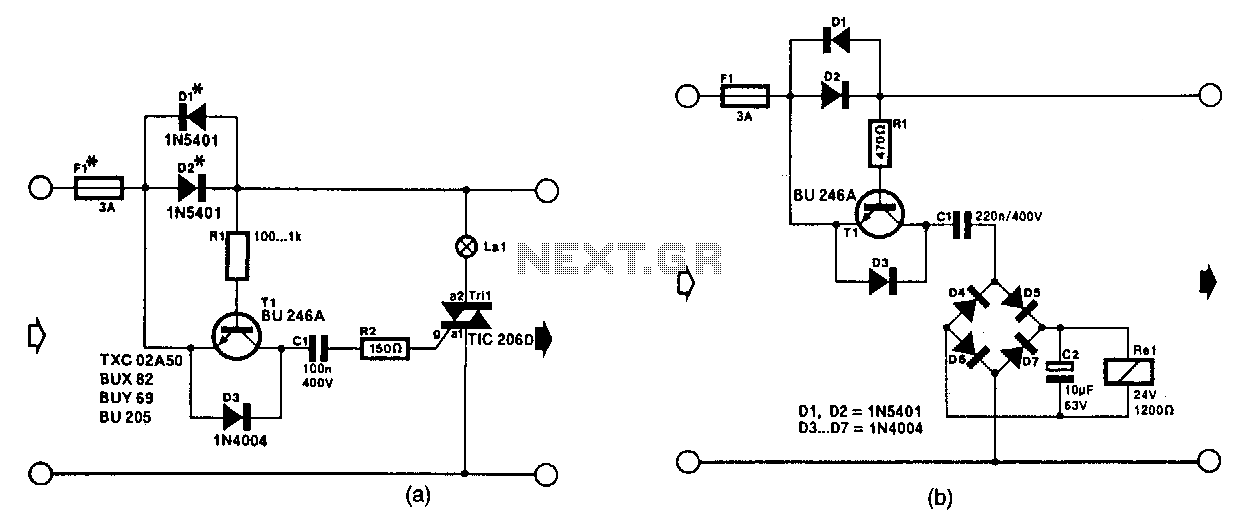
how to build fridge door alarm

The primary objective of this design is to address a minor flaw in the well-known Fridge Door Alarm circuit, which has been available on this website since 1999 and has been constructed by numerous hobbyists. This circuit unfortunately ceases to function when the battery voltage drops below approximately 2.6 to 2.7 volts. This limitation is attributed to the 4060 CMOS IC utilized in the design. In certain instances, devices produced by some manufacturers (excluding Motorola) may fail to operate even at the nominal 3V supply voltage. A straightforward solution to this issue would be to replace the original IC with a 74HC4060 chip, which would enable circuit operation down to 2V; however, this IC is not readily available. Consequently, an alternative circuit has been developed, utilizing a similar number of components, to ensure reliable operation even when the battery voltage decreases to around 1.3V. The circuit, housed in a compact enclosure, should be positioned within the fridge, ideally near the lamp (if present) or close to the door opening. When the fridge door is closed, the interior remains dark, causing the photoresistor R2 to exhibit high resistance (greater than 200K), thereby keeping IC1 clamped by maintaining capacitor C1 fully charged through resistor R1 and diode D1. When light enters through the opening or the fridge lamp is activated, the photoresistor's resistance drops (below 2K), interrupting the charging current to C1. As a result, IC1, configured as an astable multivibrator, begins to oscillate at a very low frequency, and after approximately 24 seconds, its output pin (#3) transitions high, enabling IC2. This chip is also configured as an astable multivibrator, which intermittently drives the piezo sounder at a rate of about five times per second. The alarm is activated for approximately 17 seconds before pausing for the same duration, and this cycle continues until the fridge door is closed.
The circuit design comprises several key components, including the 4060 CMOS IC (or its substitute), resistors, capacitors, a diode, a photoresistor, and a piezo sounder. The photoresistor serves as a light sensor, detecting the illumination changes when the fridge door is opened. The capacitor C1 plays a crucial role in timing the delay before the alarm is triggered. The astable multivibrator configuration of both IC1 and IC2 allows for the generation of square wave signals, which are essential for driving the piezo sounder to produce the alarm sound.
In practical application, the circuit should be enclosed in a durable, insulated box to prevent moisture ingress and ensure reliable operation in a refrigerated environment. Proper placement within the fridge is critical; positioning near the light source maximizes the sensitivity of the photoresistor, ensuring prompt activation of the alarm when the door is opened. Furthermore, the choice of components should consider temperature variations and humidity levels typical of refrigerator environments to maintain consistent performance.
Overall, this design modification enhances the functionality of the Fridge Door Alarm circuit, extending its operational voltage range and improving reliability, thereby providing an effective solution for users seeking to monitor their fridge doors effectively.The main purpose of this design was to obviate a small defect of the very popular Fridge Door Alarm circuit, available on this website since 1999 and built by a lot of hobbyists. Unfortunately, that circuit stops operating when the battery voltage falls below about 2. 6 - 2. 7 Volts. This is due to the 4060 CMos IC used. In some cases, devices made by some manufacturers (but not Motorola`s) fail to operate even at nominal 3V supply voltage. A simple cure to this shortcoming could be the substitution of the original IC specified with a 74HC4060 chip: this should allow circuit operation down to 2V but, unfortunately, this IC is not easy to locate. For this reason, an equivalent circuit using about the same parts counting was developed, in order to allow safe operation even when battery voltage falls down to about 1.
3V. The circuit, enclosed in a small box, should be placed in the fridge near the lamp (if any) or close to the opening. With the door closed, the interior of the fridge is in dark, the photo resistor R2 presents a high resistance (>200K) thus clamping IC1 by holding C1 fully charged across R1 and D1.
When a beam of light enters from the opening, or the fridge lamp lights, the photo resistor lowers its resistance (<2K) stopping C1 charging current. Therefore IC1, wired as an astable multivibrator, starts oscillating at a very low frequency and after a period of about 24 sec.
its output pin (#3) goes high, enabling IC2. This chip is also wired as an astable multivibrator, driving the Piezo sounder intermittently at about 5 times per second. The alarm is activated for about 17 sec. then stopped for the same time period and the cycle repeats until the fridge door closes. 🔗 External reference
The circuit design comprises several key components, including the 4060 CMOS IC (or its substitute), resistors, capacitors, a diode, a photoresistor, and a piezo sounder. The photoresistor serves as a light sensor, detecting the illumination changes when the fridge door is opened. The capacitor C1 plays a crucial role in timing the delay before the alarm is triggered. The astable multivibrator configuration of both IC1 and IC2 allows for the generation of square wave signals, which are essential for driving the piezo sounder to produce the alarm sound.
In practical application, the circuit should be enclosed in a durable, insulated box to prevent moisture ingress and ensure reliable operation in a refrigerated environment. Proper placement within the fridge is critical; positioning near the light source maximizes the sensitivity of the photoresistor, ensuring prompt activation of the alarm when the door is opened. Furthermore, the choice of components should consider temperature variations and humidity levels typical of refrigerator environments to maintain consistent performance.
Overall, this design modification enhances the functionality of the Fridge Door Alarm circuit, extending its operational voltage range and improving reliability, thereby providing an effective solution for users seeking to monitor their fridge doors effectively.The main purpose of this design was to obviate a small defect of the very popular Fridge Door Alarm circuit, available on this website since 1999 and built by a lot of hobbyists. Unfortunately, that circuit stops operating when the battery voltage falls below about 2. 6 - 2. 7 Volts. This is due to the 4060 CMos IC used. In some cases, devices made by some manufacturers (but not Motorola`s) fail to operate even at nominal 3V supply voltage. A simple cure to this shortcoming could be the substitution of the original IC specified with a 74HC4060 chip: this should allow circuit operation down to 2V but, unfortunately, this IC is not easy to locate. For this reason, an equivalent circuit using about the same parts counting was developed, in order to allow safe operation even when battery voltage falls down to about 1.
3V. The circuit, enclosed in a small box, should be placed in the fridge near the lamp (if any) or close to the opening. With the door closed, the interior of the fridge is in dark, the photo resistor R2 presents a high resistance (>200K) thus clamping IC1 by holding C1 fully charged across R1 and D1.
When a beam of light enters from the opening, or the fridge lamp lights, the photo resistor lowers its resistance (<2K) stopping C1 charging current. Therefore IC1, wired as an astable multivibrator, starts oscillating at a very low frequency and after a period of about 24 sec.
its output pin (#3) goes high, enabling IC2. This chip is also wired as an astable multivibrator, driving the Piezo sounder intermittently at about 5 times per second. The alarm is activated for about 17 sec. then stopped for the same time period and the cycle repeats until the fridge door closes. 🔗 External reference





